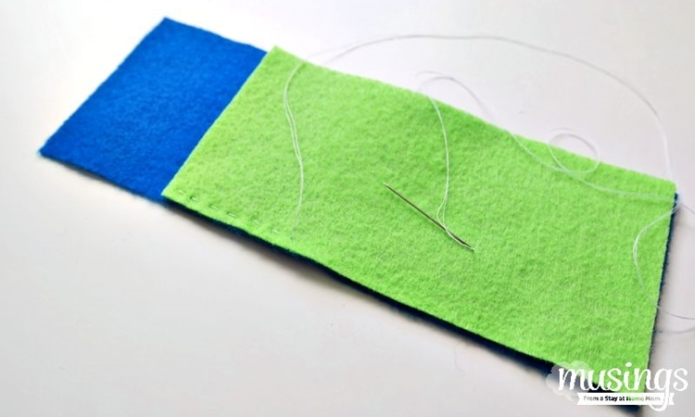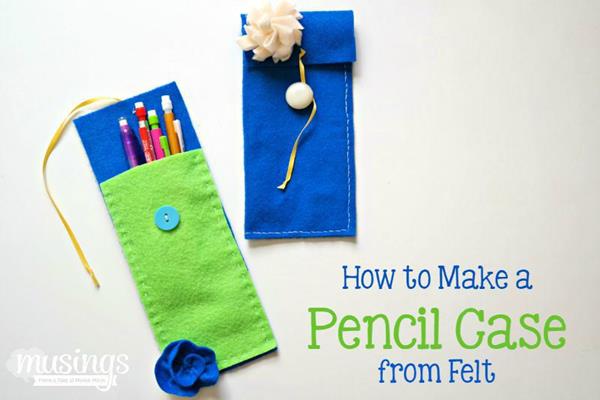Tools and materials needed to make a pencil case of flannel :
1. Flannel fabric as needed
2. Large buttons
3. Scissor
4. Cloth ribbon as necessary
5. Yarn color matching with flanneh
6. Needle
If all the materials and tools that are needed already available, then make a pencil flannel following the steps to make it :
1. Flannel scissors in 2 sizes

2. Start sewing each side of fabric

3. Pair the shorter studs

4. Sewing longer cloth ribbong

5. Pencil place was finished an can be used

Tugas Kelompok Present Simple
Simple Present Tense adalahsuatubentuk kata kerjauntukmenyatakanfakta, kebiasaan, ataukejadian yang terjadipadasaat ini.Bentuk kata kerjaini paling seringdigunakandalambahasaInggris.
Simple present tense dibentukdari verb-1 (present tense) atau linking verb “be” (is, am, are). Apaitu verb-1? Verb-1 merupakan bare infinitive dengantambahan -s atau -es (contoh verb-1: does, goes, wants) khususuntuk subject berupa singular noun (kata bendatunggal: Tita, book, car) atau third person singular pronoun (kata ganti orang ketigatunggal: she, he, it); atautanpatambahanapapun (contoh verb-1: do, go, want) untuk subject berupa plural noun (boys, men, books) atau plural pronoun (we, they), pronoun I/you, atau compound subject (you and me, Tina and Ratih).
rumus simple present tense untukkalimatpositif, negatif, daninterogatif.
| Kalimat | Rumus Simple Present Tense | Contoh Simple Present Tense |
| Positif (+) |
S + V-1 S +/- auxiliary (do/does) + bare infinitive |
She likes eating out |
| S + be (am/is/are) | The children are naughty. | |
| Negatif (-) |
S + auxiliary (do/does) + not + bare infinitive | She doesn’t like eating out |
| S + be(am/is/are) + not | The children aren’t naughty | |
| Interrogatif (?) |
Do/Does + S + bare infinitive | Does she like eating out |
| Be(am/is/are) + S | Are the children naughty |
Catatan:
Padakalimatpositif, normalnya auxiliary verb (do/does) tidakdigunakan, melainkanhanyadigunakanjikaperluuntukmemberipenekananpadakeharusanmelakukanaks.
Yang perlu diperhatikandalamkalimatpasifatau yang dikenaldenganistilah passive voice, ada yang berbentuk present, past dan future, menyesuaikandengankebutuhanwaktunya (tense). Nah untukcaramengartikannyakitabisamenyatakanbahwaadasebuahobjek(benda) yang mendapatkan (efek) darisebuahperbuatan yang dilakukansisubjek (pelaku) pada masa sekarang. Untukcarapengubahandari simple present tense berbentuk verbal menjadi present passive, perhatikanrumusnyadibawahini.
| Rumus Active Voice
Positive(+) Subject + Verb (s/es) + Object
Negative (-) Subject + do/does + not + Verb 1
Interrogative (?) Do/Does + Subject + V1 + O |
Rumus Passive Voice
Positive (+) Object + is/am/are + past participle + Subject
Negative (-) Object + is/are/ am + not + Subject
Interrogative (?) To be + O + V3 + By + S |
Contoh kalimat active dan vassive
| NO | ACTIVE | PASSIVE |
| 1. | (+)Nino talk with Ana
(-) Nino doesn’t talk with Ana (+)Does Nino talk with Ana ?
|
(+) Ana is talk with nino
(-) Ana isn’t talk with nino (?) Is Ana talk with nino? |
| 2. | (+) Dina brings a beautiful bag and wears nice shoes
(-)Dina doesn’t brings a beautiful bag and wears nice shoes (?) Does Dina brings a beautiful bag and wears nice shoes?
|
(+)A beautiful bag and wears nice shoes are brought by Dina
(-)A beautiful bag and wears nice shoes aren’t brought by Dina (?)Are beautiful bag and wears nice shoes brought by Dina? |
| 3. | (+)They learn mathematics everyday
(-)They don’t learn mathematics everyday (?)Do they learn mathematics everyday?
|
(+)Mathematics is learnt by them everyday
(-)Mathematics isn’t learnt by them everyday (?) Is mathematics learnt by them everyday? |